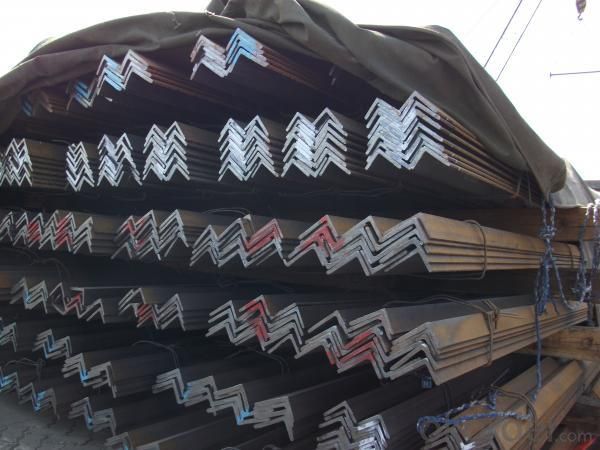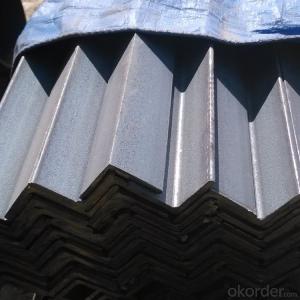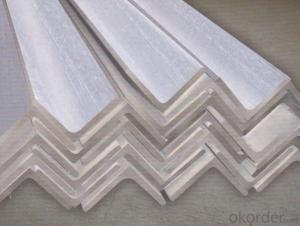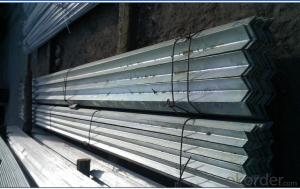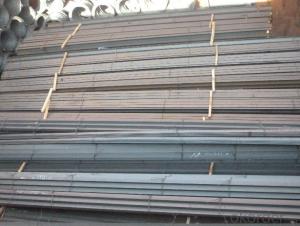Angle Steel
- Loading Port:
- China Main Port
- Payment Terms:
- TT or LC
- Min Order Qty:
- 25mtons m.t.
- Supply Capability:
- 80000-100000MTS/YEAR m.t./month
OKorder Service Pledge
OKorder Financial Service
You Might Also Like
Specifications of Angle Steel
1. Invoicing on theoretical weight or actual weight as customer request
2. Length: 6m, 9m, 12m as following table
3. Sizes
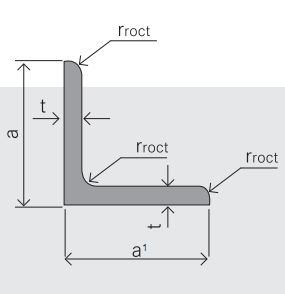
Sizes: 25mm-250mm | ||
a*t | ||
25*2.5-4.0 | 70*6.0-9.0 | 130*9.0-15 |
30*2.5-6.6 | 75*6.0-9.0 | 140*10-14 |
36*3.0-5.0 | 80*5.0-10 | 150*10-20 |
38*2.3-6.0 | 90*7.0-10 | 160*10-16 |
40*3.0-5.0 | 100*6.0-12 | 175*12-15 |
45*4.0-6.0 | 110*8.0-10 | 180*12-18 |
50*4.0-6.0 | 120*6.0-15 | 200*14-25 |
60*4.0-8.0 | 125*8.0-14 | 250*25 |
5. Payment terms:
1).100% irrevocable L/C at sight.
2).30% T/T prepaid and the balance against the copy of B/L.
3).30% T/T prepaid and the balance against L/C
6.Material details:
Alloy No | Grade | Element (%) | |||||
C | Mn | S | P | Si | |||
|
|
|
|
|
|
| |
Q235 | B | 0.12—0.20 | 0.3—0.7 | ≤0.045 | ≤0.045 | ≤0.3 | |
|
|
|
|
|
|
| |
Alloy No | Grade | Yielding strength point( Mpa) | |||||
Thickness (mm) | |||||||
≤16 | >16--40 | >40--60 | >60--100 | ||||
≥ | |||||||
|
|
|
|
|
| ||
Q235 | B | 235 | 225 | 215 | 205 | ||
Alloy No | Grade | Tensile strength (Mpa) | Elongation after fracture (%) | ||||
Thickness (mm) | |||||||
| ≤16 | >16--40 | >40--60 | >60--100 | |||
≥ | |||||||
|
|
|
|
|
|
| |
Q235 | B | 375--500 | 26 | 25 | 24 | 23 | |
Usage & Applications of Angle Steel
According to the needs of different structures, Angle can compose to different force support component, and also can be the connections between components. It is widely used in various building structures and engineering structures such as roof beams, bridges, transmission towers, hoisting machinery and transport machinery, ships, industrial furnaces, reaction tower, container frame and warehouse etc.
Packaging & Delivery of Angle Steel
1. Packing: it is nude packed in bundles by steel wire rod
2. Bundle weight: not more than 3.5MT for bulk vessel; less than 3 MT for container load
3. Marks:
Color marking: There will be color marking on both end of the bundle for the cargo delivered by bulk vessel. That makes it easily to distinguish at the destination port.
Tag mark: there will be tag mark tied up on the bundles. The information usually including supplier logo and name, product name, made in China, shipping marks and other information request by the customer.
If loading by container the marking is not needed, but we will prepare it as customer request.
Production flow of Angle Steel
Material prepare (billet) —heat up—rough rolling—precision rolling—cooling—packing—storage and transportation

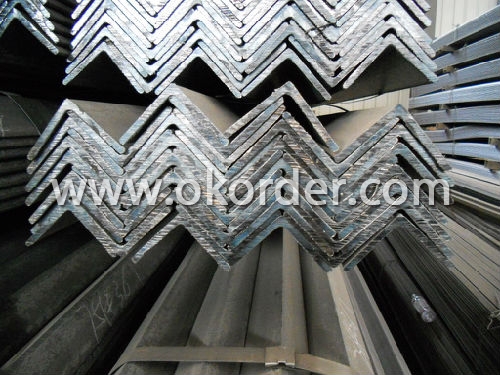
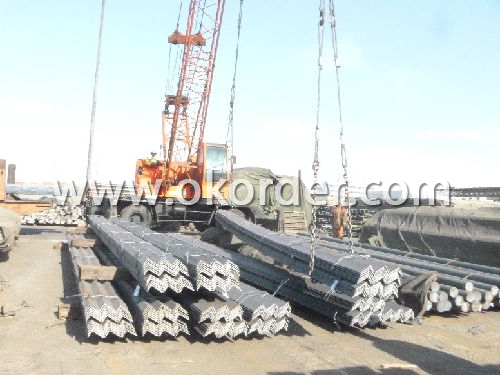
- Q: Can steel angles be used for framing in residential construction?
- Yes, steel angles can be used for framing in residential construction. They are commonly used to provide structural support and stability in various applications, including framing walls, roofs, and floors. Steel angles offer strength, durability, and versatility, making them a suitable choice for residential framing projects.
- Q: Can steel angles be used for cable trays?
- Yes, steel angles can be used for cable trays. Steel angles provide structural support and stability, making them suitable for holding cable trays securely in place. They are commonly used in cable tray installations due to their strength and durability.
- Q: Can steel angles be recycled?
- Indeed, it is possible to recycle steel angles. Steel, being one of the most recycled materials globally, also applies to steel angles. Once steel angles are deemed unnecessary or have fulfilled their lifespan, they can undergo collection, processing, and transformation into fresh steel products. By recycling steel angles, the conservation of natural resources, reduction of energy consumption, and minimization of waste are achieved. Consequently, steel angles prove to be an environmentally conscious and sustainable option for construction and various other applications.
- Q: What are the different types of steel angles used in material handling systems?
- Material handling systems commonly utilize various types of steel angles for structural support and reinforcement. The following are some examples of the different steel angles used in these systems: 1. Equal Leg Angles: These angles possess equal sides and play a crucial role in providing structural support within material handling systems. Their application is typically seen in scenarios where the load is evenly distributed. 2. Unequal Leg Angles: These angles are characterized by unequal sides. They find utility in material handling systems where the load distribution is not uniform. By offering design flexibility, unequal leg angles enable the system to accommodate different load requirements. 3. L-Shaped Angles: L-shaped angles are frequently employed in material handling systems. They serve to form corners or connect various components together. These angles enhance the system's stability and provide reinforcement, particularly at joints and intersections. 4. Slotted Angles: Slotted angles are versatile steel angles that possess a series of holes along their length. These holes facilitate easy adjustment and customization of the material handling system. They are often utilized in the creation of shelving units, workbenches, and other storage solutions. 5. Perforated Angles: Similar to slotted angles, perforated angles feature a pattern of holes across their surface. These holes enhance ventilation and drainage within the material handling system. Common applications for perforated angles include conveyor systems and storage racks where airflow or liquid drainage is essential. 6. Stainless Steel Angles: Stainless steel angles offer high resistance to corrosion and are prevalent in material handling systems operating in harsh environments or requiring hygienic conditions. They excel in applications that prioritize cleanliness, durability, and rust resistance. These examples highlight just a few of the numerous steel angle types employed in material handling systems. The selection of the appropriate angle depends on specific system requirements such as load capacity, structural integrity, and environmental factors. Consulting a professional engineer or designer is crucial in determining the most suitable steel angle for a material handling system.
- Q: What are the typical lead times for steel angle orders?
- Lead times for steel angle orders can vary based on a variety of factors. Standard steel angles that are readily available in stock typically have lead times ranging from a few days to a week. This is because steel suppliers commonly produce and keep these standard sizes in inventory. However, if the steel angle order requires specific dimensions, finishes, or special requirements, the lead times may be longer. Custom or non-standard steel angles may need to be fabricated or sourced from mills, which can add extra time to the order fulfillment process. Depending on the complexity of the specifications and the availability of materials, lead times for these orders can range from a few weeks to several months. It is important to keep in mind that external factors like market demand, production schedules, and transportation logistics can also influence lead times. Therefore, it is advisable to communicate with the steel supplier or manufacturer to obtain an accurate estimation of lead times for specific steel angle orders.
- Q: What are the different methods for cutting steel angles?
- There are several different methods for cutting steel angles, including using a bandsaw, a chop saw, an angle grinder, a plasma cutter, or a laser cutter. The choice of method depends on factors such as the thickness of the steel, accuracy requirements, and the desired finish.
- Q: Are steel angles suitable for bridge construction?
- Yes, steel angles are suitable for bridge construction. They are commonly used as structural elements in bridge construction due to their strength, durability, and versatility. Steel angles offer excellent load-bearing capacity and can be easily fabricated and connected to form various bridge components such as trusses, beams, and girders. Their ability to withstand heavy loads and resist deformation makes them an ideal choice for bridge construction projects.
- Q: How do you calculate the bending moment of a loaded steel angle?
- In order to calculate the bending moment of a loaded steel angle, it is necessary to take into account the applied load, the moment arm, and the cross-sectional properties of the angle. Firstly, one must ascertain the applied load that is acting on the steel angle. This can either be a point load or a distributed load, depending on the specific circumstances. Following this, the point of application of the load must be identified and the moment arm determined. The moment arm represents the perpendicular distance between the point of application of the load and the axis of rotation. Once the applied load and moment arm are known, the bending moment can be calculated using the formula: Bending Moment = Applied Load x Moment Arm Lastly, the cross-sectional properties of the steel angle need to be taken into consideration. These properties encompass the area moment of inertia (I) and the section modulus (Z). The area moment of inertia gauges the resistance to bending and is contingent upon the shape and dimensions of the angle. The section modulus denotes the strength of the section and is computed by dividing the area moment of inertia by the distance from the centroid to the extreme fiber. By employing the appropriate equations and taking into account the cross-sectional properties, it is feasible to ascertain the bending moment capacity of the loaded steel angle and evaluate its structural integrity under the given load conditions.
- Q: What are the dimensions of a standard steel angle?
- The dimensions of a standard steel angle typically include the length of the legs and the thickness of the steel.
- Q: Can steel angles be used in railway infrastructure?
- Railway infrastructure can utilize steel angles. These L-shaped structural steel components, commonly referred to as steel angles, have a wide range of uses in the construction industry, including railway infrastructure. They are frequently employed in the creation of railway tracks, bridges, support structures, and other elements of the railway system. The reasons steel angles are favored in railway infrastructure are due to their exceptional strength, durability, and versatility. They are capable of withstanding heavy loads and providing excellent structural support, which makes them ideal for the demanding conditions of railway tracks and structures. Additionally, steel angles are resistant to corrosion, a crucial feature for railway infrastructure that is exposed to harsh environmental conditions. Within railway tracks, steel angles are often employed as base plates, connecting the rails to the sleepers or ties. Their use ensures stability and equal distribution of the load, thereby guaranteeing the safe and smooth operation of trains. Moreover, steel angles are utilized as the primary structural element for supporting the weight of trains in bridge construction. Furthermore, steel angles are easily fabricated and installed, making them a cost-effective choice for railway infrastructure projects. They can be cut, welded, and shaped to meet specific design requirements, enabling efficient construction and customization. In conclusion, steel angles have proven to be a dependable and efficient option for railway infrastructure. Their strength, durability, and versatility make them suitable for various applications within the railway system, thereby contributing to the safety and efficiency of train operations.
1. Manufacturer Overview
| Location | Hebei, China |
| Year Established | 2003 |
| Annual Output Value | Above US$ 500 Million |
| Main Markets | Southeast Asia; middle east; South Korea; Africa |
| Company Certifications | ISO 9001:2008 |
2. Manufacturer Certificates
| a) Certification Name | |
| Range | |
| Reference | |
| Validity Period |
3. Manufacturer Capability
| a) Trade Capacity | |
| Nearest Port | Tianjin |
| Export Percentage | 30%-45% |
| No.of Employees in Trade Department | 11-20 People |
| Language Spoken: | English; Chinese |
| b) Factory Information | |
| Factory Size: | Above 10,000 square meters |
| No. of Production Lines | 2 |
| Contract Manufacturing | OEM service offered |
| Product Price Range | high; average |
Send your message to us
Angle Steel
- Loading Port:
- China Main Port
- Payment Terms:
- TT or LC
- Min Order Qty:
- 25mtons m.t.
- Supply Capability:
- 80000-100000MTS/YEAR m.t./month
OKorder Service Pledge
OKorder Financial Service
Similar products
Hot products
Hot Searches
Related keywords



